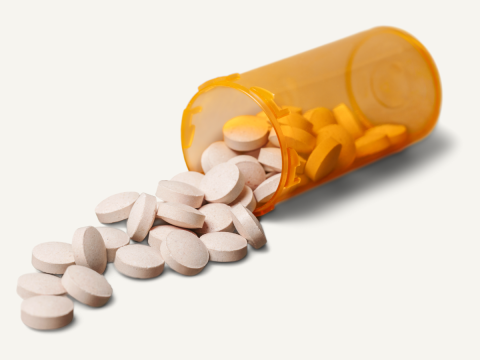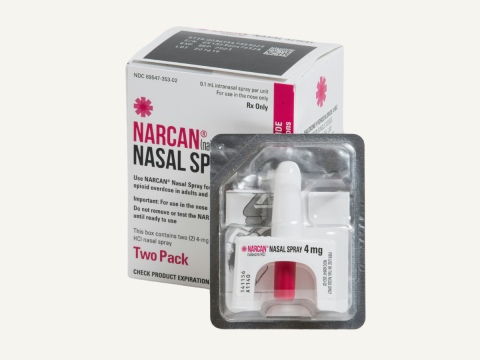DEA ALERT: Illegal Online Pharmacies
October 4, 2024 – The U.S. Drug Enforcement Administration has seen an increase in illegal online pharmacies selling and shipping counterfeit pills made with fentanyl and methamphetamine to unsuspecting customers in the United States who believe they are purchasing real pharmaceutical drugs such as Oxycodone, Adderall, Xanax, and other drugs from legitimate pharmacies. LEARN MORE
The Opioid Crisis
- Use of opioids, either alone or in combination with other drugs, is a major driver of the drug overdose crisis in the United States.
- In 2023, opioids were responsible for an estimated 107,543 overdose deaths in the United States.
- The State of New Hampshire has had among the highest rates of fentanyl-related overdose deaths per capita in the United States for several years in a row.
- The vast majority of overdose deaths in recent years involved illegally produced and sold counterfeit pills. These pills are dangerous because they typically appear as pharmaceutical pills but often contain illegally made fentanyl or other drugs, with or without people's knowledge.
Opioid Overdose
- Opioid overdose can happen to anyone, and deaths are preventable.
- On college campuses, almost one-third of students say they know someone who has overdosed on opioids or other drugs.
- The increasing prevalence of fentanyl in the illicit drug supply has significantly increased risk for overdose.
- Even when taking opioid medications for pain as prescribed, risk of accidental overdose remains a concern, especially when considering the risk of drug-drug interactions.
Help Prevent Overdose!
- Use Narcan to reverse possible opioid/fentanyl overdose.
- Use Fentanyl Test Strips (FYS) to test pills and powder substances/drugs for fentanyl contamination.
Source: NIH National Institute on Drug Abuse (NIDA) and Centers for Disease Control and Prevention (CDC)
Resources for Support and Learning
If you or someone you know is affected by the use of opioids or other drugs, community resources can provide you with knowledge and understanding, the opportunity to share experiences and struggles, and the ability to find success through recovery.
Get Support
- Talk with a Health & Wellness Alcohol, Nicotine and Other Drug (ANOD) Educator / Counselor for support and education and referral to resources as appropriate. Services are confidential and covered by your UNH Health Fee. Learn more and schedule a session
- Contact The Doorway operated by Wentworth Douglas Hospital for assistance. Services include:
- Telephone screening and crisis stabilization
- In-person screening and crisis stabilization
- Evaluation
- Care planning
- Facilitated referral
- Continuous recovery monitoring
- Naloxone (Narcan) distribution
- Transportation assistance
Learn More and Get Training
- Complete the UNH Cooperative Extension Community First Responder Program. This free, short online training informs on how to identify and respond in an overdose situation. Upon completing the training, you can request a free Narcan, FTS and Xylazine testing kit that is mailed directly to your address.
- Explore the interactive online module, "Signs, Symptoms, and Risk Factors for a Bad Reaction to Opioids," to test and enhance your knowledge.
- Access information through Addiction Recovery Coalition New Hampshire (ARCNH) or New Hampshire Harm Reduction Coalition (NHHRC).
Frequently Asked Questions (FAQS)
- Opioids are a highly addictive class of drugs that bind to and activate opioid receptors on cells located in many areas in the body, especially those involved in feelings of pain and pleasure.
- In the short term, opioids reduce the perception of pain and can also cause drowsiness, confusion, euphoria, nausea, and constipation.
- At high doses, opioids can slow breathing which can lead to overdose and death.
- Opioids are chemical compounds that generally are not derived from natural plant matter. Most opioids are "made in the lab" or "synthesized."
- Examples of well-known opioids used medically in the U.S.:
- Dextromethorphan (available in the U.S. without prescription, e.g., NyQuil, Robitussin, TheraFlu, Vicks)
- Dextropropoxyphene (e.g., Darvocet-N, Darvon)
- Loperamide (e.g., Imodium)
- Hydrocodone (e.g., Vicodin)
- Oxycodone (e.g., Oxycontin, Percocet)
- Oxymorphone (e.g., Opana)
- Meperidine (e.g., Demerol)
- Methadone (e.g., Dolophine)
- Fentanyl/fentanil (e.g., Ultiva, Sublimaze, Duragesic patch
- Carfentanyl/carfentanil (e.g., Wildnil, for veterinary use)
- Fentanyl is a synthetic (made in a laboratory) opioid that is up to 50 times stronger than heroin and 100 times stronger than morphine.
- Fentanyl is a major contributor to fatal and nonfatal overdoes in the United States. Even in small does it can be extremely dangerous.
- Most cases of fentanyl-related overdose are linked to illegally made fentanyl. It is often added to other drugs because it is extremely potent, which makes drugs cheaper, more powerful, more addictive, and more dangerous.
- Drugs mixed with fentanyl are extremely dangerous; many people may not be aware their drugs contain it.
- Illegal fentanyl is available as a liquid or powder.
- The liquid form can be found in nasal sprays, eye drops, and dropped onto paper.
- Powder fentanyl can be mixed with heroin, cocaine, methamphetamine, or illicitly obtain prescription medications such as Adderall.
One pill can kill.
- Counterfeit prescription drugs, such as Adderall, containing fentanyl or other illicit drugs increase the risk of an overdose. Only take medication prescribed by medical provider and obtained from a licensed pharmacy.
- It is nearly impossible to detect fentanyl in a drug unless you test your drug with fentanyl test strips. LEARN MORE ABOUT COUNTERFEIT PILLS & FENTANYL TEST STRIPS
Possibly. Fentanyl is a leading cause of opioid overdose because it is commonly incorporated into the illicit drug supply. Psychedelics, cannabis, study drugs, and counterfeit pills are some of the many drugs that can be tainted with fentanyl.
Counterfeit pills are made to look just like prescription Xanax, Percocet, painkillers like Vicodin and Oxycodone, and stimulants like Adderall. If you consume substances that are not prescribed for you and are not sourced from a licensed pharmacy, you take the risk of ingesting substances contaminated with fentanyl. This may result in accidental overdose, especially if combined with alcohol or other substances. Using fentanyl test strips (FTS) before consuming a drug allows you to make an informed choice.
Alcohol and other drug use, including opioid use, is a reality in any community, including on college campuses.
According to the Fall 2023 American College Health Association National College Health Assessment (ACHA-NCHA), administered to students at all three UNH campuses (Durham, Concord, and Manchester), respondents disclosed non-medical use of opioids as follows*:
- Ever used: 2.6%
- Used in the last 3 months: 0.3%
Respondents disclosed use of non-medical use of prescription stimulants (which pose the risk of fentanyl contamination) as follows*:
- Ever used: 6.8%
- Used in the last 3 months: 2.1%
For the Durham campus alone (ACHA-NCHA 2021), non-medical use of prescription stimulants almost doubles, with 11.2% having ever used and 5.1% having used in the last 3 months.
*1,144 survey respondents; response rate 13.6%
An Important Note About Judgment and Stigma
When discussing risks associated with use or exposure to opioids or other drugs, it is important to refrain from value judgements. Stigma will decrease the likelihood that a student affected by drug use, whether it be their own or that of a peer, will seek support.
There is no evidence showing that access to harm reduction measures such as Narcan or FTS increases the rates of opioid or other drug use. Due to the impacts of opioid use on health and safety, providing these resources can help protect our community, which is why Narcan is widely available at college campuses across the nation.
Xylazine is not an opioid but can cause similar sedative effects. It is a very strong sedative used in veterinary medicine, not approved for use in humans. According to the CDC, Xylazine is present in many fentanyl and opioid related deaths. It causes effects such as sedation, slow breathing, slow heart rate, low blood pressure, wounds that can become infected, and death.
Xylazine Test Strips can be accessed at no cost through The Doorway - Operated by Wentworth-Douglas Hospital (Dover, NH) or can be mailed to you directly by completing The UNH Cooperative Extension Community First Responder Program.
- https://www.colorado.edu/health/blog/fentanyl
- https://www.unh.edu/health/alcohol
- https://www.cdc.gov/stopoverdose/fentanyl/index.html
- https://www.cdc.gov/opioids/basics/terms.html
- https://nida.nih.gov/publications/drugfacts/prescription-opioids#:~:text=Opioids%20are%20a%20class%20of,body%20and%20can%20relieve%20pain
- https://drugfree.org/article/substances-laced-with-fentanyl/
- https://www.dea.gov/factsheets/fentanyl
- https://www.cdc.gov/stopoverdose/polysubstance-use/index.html
- https://rise.articulate.com/share/iXDfgJgFA4PHDdpmefJ7OxERvxMVobrw#/lessons/fq0V1ZD0y4YiiwHSW_fpZhbOOvlA2lPV
- https://www.ue.org/risk-management/health-and-well-being/respond-to-student-opioid-overdoses/
- https://www.cdc.gov/drugoverdose/deaths/other-drugs/xylazine/faq.html



